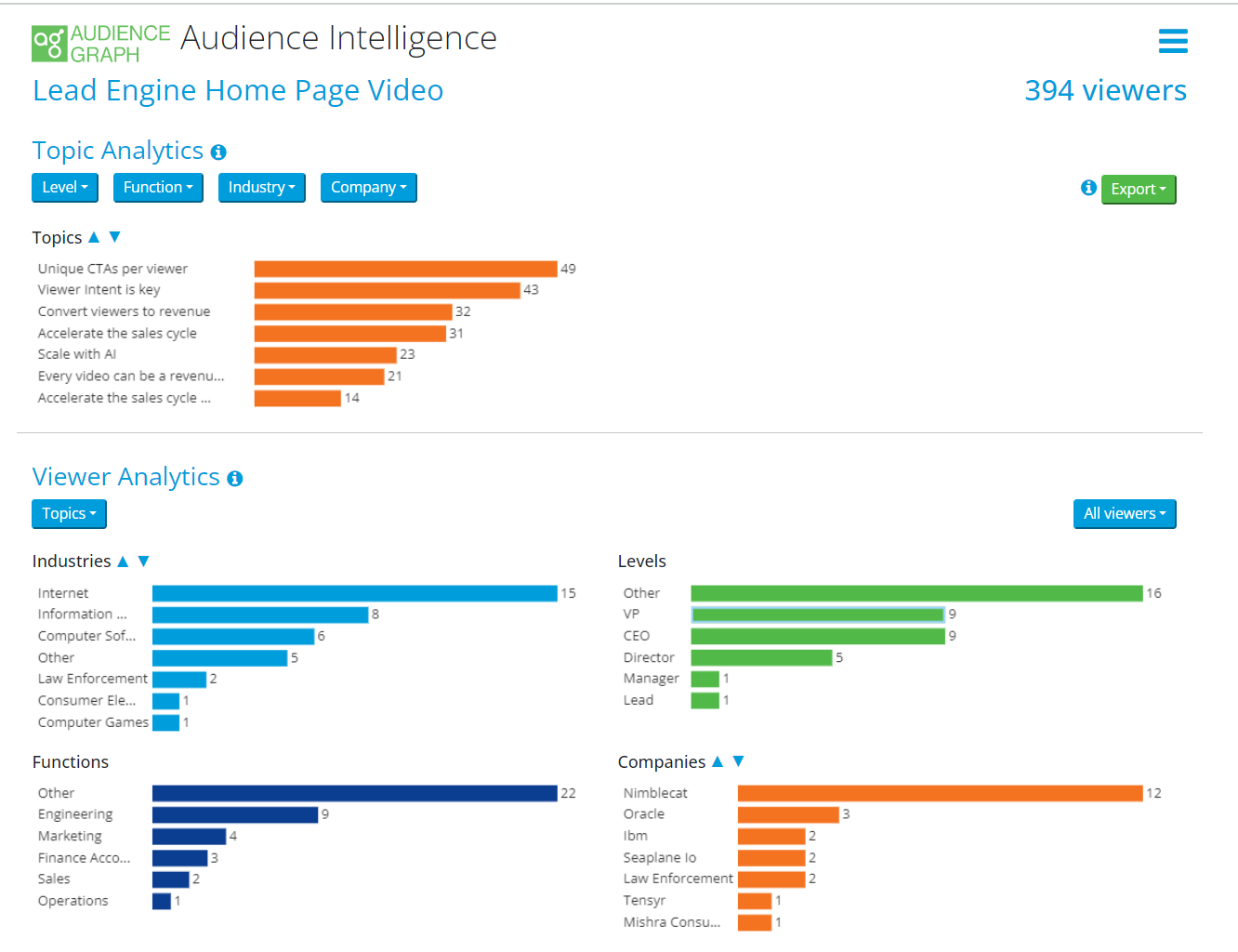Drive Engagement with Detailed Video Analytics

Jul 12, 2023
In my previous post, Is Marketing Automation up to the challenge of Video I made the case that per viewer analytics were necessary to make Video Marketing Automation effective. In this post, I’ll go into some more detail on how you can track viewers within your video, give you an example of per-viewer and per-topic analytics and then discuss how they can be used to engage viewers while they’re watching your video.
- Track viewers within your video
- Per-viewer and per-topic analytics
- Engage viewers on what they’re watching
- Customize CTAs to each viewer
Track viewers within your video
The only analytics you get from video today are aggregate analytics on total and unique viewers, watch time, viewer drop off and variants of those metrics. If you have CTAs on your video, you might also get the number of hits on your CTAs. These kinds of aggregate analytics are very useful for content strategists. They use this data to create additional content around topics that are of most interest to their viewers.
In most cases, however, this data is not real-time. It is usually only available after it's been added to a data warehouse, so the delay between when the data was collected and when it’s available for use might be days or weeks.
Secondly, this data has no information to help sales because it is aggregate data and does not identify individual users, either anonymously or as they provide their contact information. Ideally, the sales team needs to know the details of viewers who watched the video. When they have that, they can target these viewers as prospects.
What you also need to know is which parts of the video were watched. This is useful in multifold ways. You now know exactly what content the viewer watched. This helps the sales team know a potential lead better. The marketing team takes the information about the viewers and in subsequent campaigns, targets them with content customized to their preferences. This increases viewer retention recursively with each round of content.
Per-viewer and per-topic analytics
.Let's take a look at what per-viewer and per-topic analytics might look like. We’re going to use a screenshot of the analytics page from our company’s product, AudienceGraph. These are the analytics from the video at https://graphtech.ai. Of course, this is what we think detailed video analytics should look like.

The first half of the page shows which topics in your video are getting the most attention. The second half of the page gives you a snapshot of viewers by topic. Read on for more detail.
The Topic Analytics section
Let us take the topic ‘Viewer intent is key’. This tells you that 43 people went to this point in the video. The diagram does not show this detail, but you can narrow down the data further by Job Level, Job Function, Industry and Company. The marketing department can do very fine grained targeting in future videos with this information. And the sales team will find the information on job function and job level useful.
The Viewer Analytics section
Let us take this even one step further. For each topic you can see data on how many people in each industry watched it,and what their job levels and job functions were. You also get the companies they worked at. Your sales and marketing team can now use this very detailed data to fine tune every part of their execution and strategy.
Engage viewers on what they’re watching
The detailed video analytics that I spoke about in the previous section are a generation beyond the sparse analytics marketers get today. But if we view analytics only as tables and charts we miss out on a very important capability - the potential to drive real time engagement with your viewers. In fact, the best time to convert a viewer into a lead is when they’re already engaged with your content!
Imagine that you could enable any viewer to kick off a conversation with one of your sales or market team while they were watching your video. Imagine also that the team member on your end knew exactly what the viewer was watching at that time. They could then start the chat with something immediately relevant to the viewer rather than the standard “what can I help you with?” response. And, this is the perfect time to request a name and email from your viewers. You might even go one step further and ask them for their company affiliation and title.Not everyone will tell you, but serious viewers are likely to, especially when they have an expectation of learning something in return.
A good video marketing platform should also let your viewers engage with you later. Offer them a chance to book a meeting, for example. Chat now or book a meeting - it’s a win-win both ways.
Customize CTAs to each viewer
If you’re familiar with the call to action capability offered by most video marketing platforms, you know that they all let you add CTAs to your video. YouTube, for example, lets you insert cards within your video or add them at the beginning or end of your video. So do other popular platforms like Wistia and Vidyard. There are a couple of issues with this approach, however:
- You interrupt the viewer’s experience with CTA cards. Proponents of this approach will argue that this forces the viewer to consider your CTA. After all, it's just like ads on TV.
- You present the same CTA to every viewer, regardless of who they are or where they are in their purchasing journey.
There is another approach that can get better results. But it works only if you know what each viewer is watching now and what they’ve watched previously. If you have access to detailed per viewer analytics of the sort I discussed earlier, you can present a different CTA to each viewer. And you can use powerful AI powered methods to estimate which CTA will be most effective for that viewer at that time.
Takeaways
Aggregate viewer analytics of the sort provided by YouTube and other video marketing platforms are useful. But as I’ve pointed out in this post they are primarily useful to content marketers. And, even for them, their usefulness is limited. If you need to drive revenue from video, you need per-viewer analytics. If you’d like to find out more on this topic and learn about AudienceGraph, take a look at graphtech.ai.
About GraphAI
GraphAI is creating the next generation of web pipeline generation for for growth, GTM and ABM teams. Explore the GraphAI platform and products from the menu above
Recent Posts
They're not following your customer journey!
Feb 25, 2025
Your Video Should Be a Dialog
Aug 03, 2023
Being Smart About AI
Jul 11, 2023
Is Marketing Automation Up To The Challenge Of Video?
Jun 22, 2023
You Need Better Video Marketing Analytics
Jun 21, 2023

